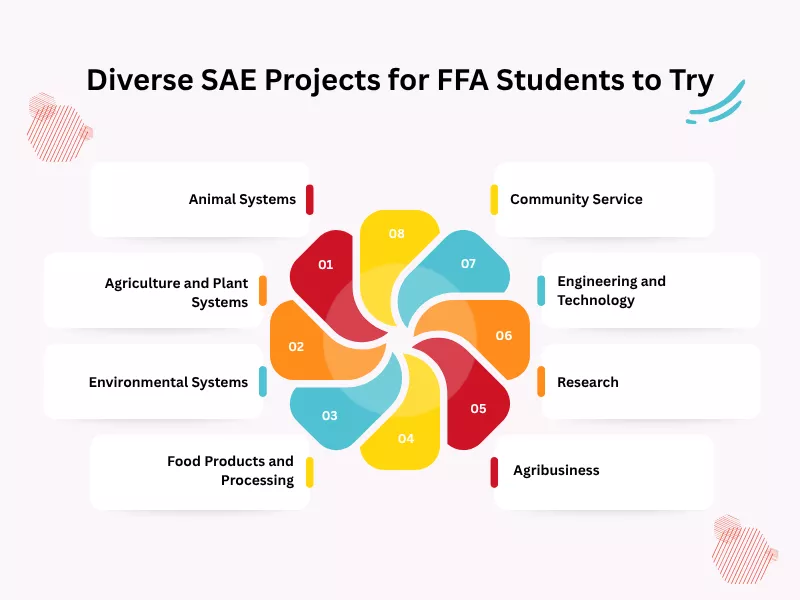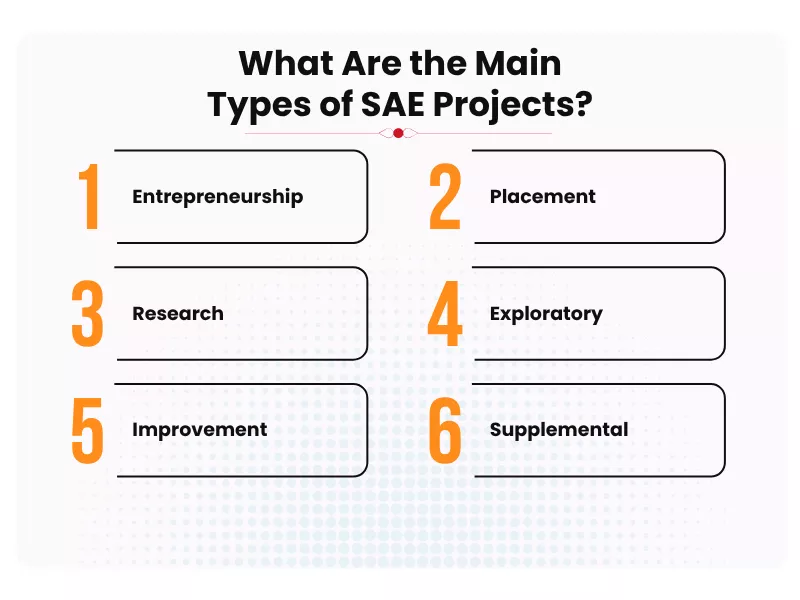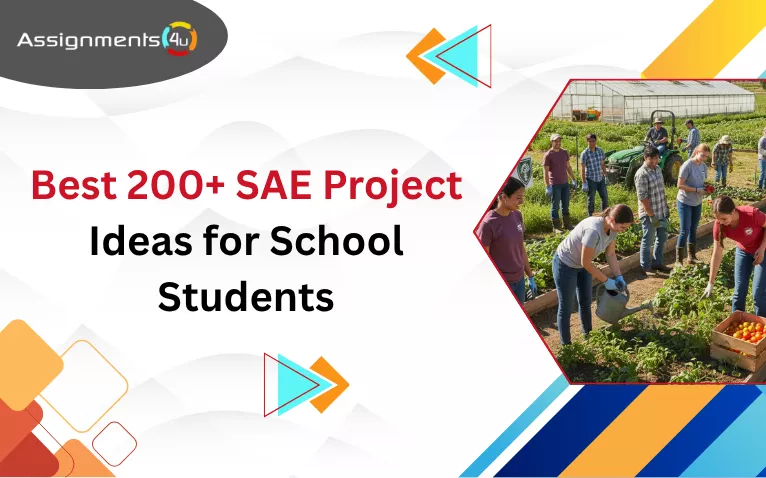Having the right project can make all the difference if you’re preparing for the Future Farmers of America (FFA) program. The best project starts with a better idea! However, we understand that it’s difficult and tiring to find project ideas for high school as only 35–40% get continuous supervision so a lack of continuous supervision can also be a challenge. Also, 47% of instructors stated that there is a funding shortage for completing an SAE project.
To make things easier, we’ve curated a list of 200+ simple yet unique SAE project ideas designed especially for high school students. These ideas will help you stand out, learn valuable skills, and impress your evaluators. Other than this, we have also discussed the use of the SAE Project, its benefits, and types as well. So enjoy our blog, and hopefully it can help you.
Table of Contents
What Is the Use of an SAE Project?
A Supervised Agricultural Experience (SAE) project gives students practical, hands-on experience in agriculture under a teacher’s guidance. These projects connect classroom learning with real-world, career-focused applications.
The purpose of SAE programs is to provide hands-on learning in real-world settings. Students also learn about career paths and employment in agriculture.
Diverse SAE Projects for FFA Students to Try

Animal Systems
Students can gain hands-on experience by raising and exhibiting livestock such as cattle, pigs, or sheep. Other options include producing eggs from backyard chickens, keeping bees for honey production, creating goat milk-based soaps, or running a pet-sitting or small animal care service.
Agriculture and Plant Systems
Opportunities in plant systems include establishing a vertical hydroponic farm for lettuce, cultivating microgreens for local restaurants, designing gardens that attract pollinators, grafting fruit trees, or managing a school or community vegetable garden.
Environmental Systems
Projects can focus on sustainable practices such as designing a rainwater collection system, offering composting services, implementing soil erosion control methods, or restoring native plant habitats in local areas.
Food Products and Processing
Students can create value-added agricultural products like fruit leather, artisanal cheeses, fermented vegetables, or flavored popcorn. These projects provide experience in both production and marketing.
Agribusiness
Agribusiness projects might involve developing a farm-to-table mobile app, running a community-supported agriculture (CSA) program, offering financial planning for farms, or designing a visually appealing farmers’ market booth.
Research
Research-focused projects allow students to explore topics such as the effects of various fertilizers on crop growth, the benefits of crop rotation on soil health, evaluating organic pest control methods, or testing water conservation strategies. These are SAE Research Project Ideas.
Engineering and Technology
Students can combine agriculture with technology by building solar-powered chargers, designing automated irrigation systems with Arduino, constructing small windmills for electricity generation, or developing drone-based crop monitoring solutions.
Community Service
Community-focused projects include organizing food drives, leading school recycling initiatives, establishing community gardens, or supporting agricultural therapy programs for local organizations. One of the most important skills that you’ll need here is communication, so you can see our Demonstration Speech Ideas before going for community service.
List of 100 + Innovative SAE Project Ideas for Students
Assignments4u has been offering premium assignment help services for over 2 decades. Our PhD-qualified experts have curated SAE project ideas for you with their years of expertise, hands-on experience, and knowledge, so you get an edge! Here are some SAE Project Ideas for Students from our experts, which may help with the upcoming SAE Project.
Business and Entrepreneurship Projects
- Homegrown Vegetable Stand
- Organic Herb Sale
- DIY Compost Business
- Farm-Based Social Media Marketing
- Seasonal Flower Sale
- Homemade Jam or Pickle Business
- Egg Delivery Service
- School or Community Garden Management
- Agri-Tourism Mini Project
- Recycled Planter Sale
- DIY Bird Feed Production
- Local Farmers’ Market Stall
- Value-Added Fruit Products.
- Herbal Tea Business.
- Seed Packet Sale.
- Small Livestock Sales.
- Mini Landscaping Service.
- Farm Produce Subscription Box.
- DIY Fertilizer or Natural Pesticide Sale.
- Educational Workshop for Kids.
Engineering and Technology Projects
- Automated Irrigation System.
- Solar-Powered Water Pump.
- Mini Wind Turbine for Farm Energy.
- Smart Greenhouse Automation.
- Drone for Crop Monitoring.
- Automatic Feed Dispenser for Livestock.
- Hydroponic or Aquaponic System.
- Temperature-Controlled Storage Box.
- DIY Soil Moisture Sensor.
- Solar Dryer for Fruits or Herbs.
- Automated Plant Growth Tracker.
- Small Robotic Weeder.
- Rainwater Filtration & Storage System.
- Portable Solar-Powered Cooler.
- Arduino-Based Farm Monitoring System.
- Automated Greenhouse Ventilation System
- Solar-Powered Electric Fence
- IoT-Based Farm Monitoring App
- LED Grow Light Optimization.
- Solar-Powered Insect Trap
Agricultural Science Projects
- Organic Fertilizer Comparison.
- Soil pH Testing.
- Germination Rate Experiment.
- Effect of Watering Frequency on Plant Growth.
- Growing plant with Different Types of Mulch.
- Hydroponic Lettuce Experiment.
- Natural Pest Repellent Study.
- Compost Bin Efficiency Test.
- Effect of Sunlight on Leaf Color.
- Vertical Gardening Experiment.
- Germination with Cold Stratification.
- Impact of Soil Texture on Plants.
- Water Filtration with Plants
- Effect of Different Fertilizers on Flower Blooming.
- Microgreens Growth Study.
- Effect of Salt Concentration on Plant Growth.
- Seed Storage Experiment.
- Biodegradable Mulch Impact on Soil Health.
- Leaf Compost vs. Grass Clippings.
- Effect of Coffee Grounds on Soil Fertility.
Community Service Projects
- Neighborhood Vegetable Patch
- Tree Plantation Drive
- Recycling Awareness Campaign
- Compost Workshop
- Bird or Pollinator Habitat
- Water Conservation Project
- Neighborhood Cleanup Drive
- School Herb Garden for Cooking Classes
- Local Farm Support Program
- Community Seed Bank
- Awareness on Sustainable Farming
- Vegetable Donation Program
- Mini Greenhouse for Schools
- Plastic-Free Farm or Garden
- Educational Posters on Agriculture
- Home Compost Bin Installation
- School Rain Garden Project
- Wildflower Garden for Pollinators
- Soil Testing Assistance for Local Gardeners
- Awareness Drive on Local Agriculture Careers
Environmental Science Projects
- Rooftop Water Collection Project
- School or Community Composting Project
- Air Quality Monitoring
- Solar Oven Project
- Plastic Waste Reduction Campaign
- Tree Growth Monitoring
- Energy Consumption Awareness
- DIY Water Filtration System
- Creating a Pollinator Garden
- Erosion Control Study
- Upcycled Planter Project
- Organic Mulch Comparison.
- Local Wildlife Observation Journal
- Recycling Awareness Workshop
- Water Pollution Study
- Schoolyard Green Roof Project
- DIY Solar-Powered Water Heater.
- Native Plant Restoration
- Eco-Friendly Cleaning Campaign
- Carbon Footprint Awareness Program.
Best SAE Project Ideas for High School Science Students
Unique Biology SAE Project Ideas for FFA and Science Students
- Effect of Natural Light Pollution on Plant Growth
- Microbiome Study of Household Surfaces
- Impact of Acid Rain on Plant Health.
- Investigating Plant-Microbe Symbiosis
- Study of Fungal Growth on Different Food Types
- Effects of Sound Vibrations on Seed Germination
- Comparing Pollinator Visits on Native vs. Non-Native Flowers
- Investigation of Plant Allelopathy
- Effect of Temperature on Aquatic Microorganisms
- Seed Dormancy and Germination Study
High School Chemistry SAE Project Ideas for Beginners
- Effect of Natural Acids on Metal Corrosion
- Homemade pH Indicator from Plants
- Effect of Temperature on Enzyme Activity in Foods
- Testing Natural Preservatives in Food
- Investigating Electrolysis of Different Salt Solutions
- Comparing the Biodegradability of Household Detergents
- Effect of Caffeine or Sugar on Yeast Fermentation Rate
- Testing Water Hardness Using Simple Chemical Methods
- Effect of Different Types of Oils on Fire Safety
- Creating a Natural Dye from Spices and Plants
Physics Project Ideas for Beginners
- Homemade Hovercraft Investigation
- Effect of Different Balloon Sizes on Air Pressure Propulsion
- Measuring the Efficiency of Homemade Water Wheels
- DIY Electromagnet Strength Study
- Effect of Different Materials on Solar Oven Temperature
- Homemade Thermoelectric Generator
- Pendulum Damping with Different Fluids
- Investigating Buoyancy with 3D Shapes
- DIY Wind-Powered Vehicle Efficiency
- Investigating the Effect of Mass Distribution on Spinning Tops
Unique Biotechnology Project Ideas
- Testing Natural Antimicrobials on Bacteria
- DIY Bioplastic from Starch or Gelatin
- Investigating Probiotic Effects on Yeast Growth
- Studying CRISPR Simulation in Bacterial Models
- Analyzing Enzyme Activity in Different Fruit Juices
- Effect of Temperature and pH on Fermentation
- Testing Bioremediation Capabilities of Microbes
- Comparing Methods of Plant DNA Extraction.
- Microbial Fuel Cell Investigation
- Investigating Antioxidant Effects on Microbial Growth
Top Home-Based SAE Project Ideas for Students

Here are a few suggestions for Sae project ideas at home, and these can also be considered as SAE project ideas for high school as well.
Home Composting Examination
Study how kitchen and garden waste can be turned into compost. Here you can identify which method produces the best nutrient-rich compost for plants.
Hydroponic Herb Garden
Create a small hydroponic setup to grow herbs like basil or mint without soil. In addition, this will help you to understand the farming methods and resource optimisation.
DIY Rainwater Filtration System
If you’re looking for Student Council Ideas, then this point is perfect for you. For example, you can collect rainwater in a container and layer sand and gravel in a filter tube or bottle. After this, observe the water clarity and test it with water quality kits. This will help you teach water purification and conservation.
Household Waste Biogas Project
Here, you will learn how everyday kitchen and garden waste can be turned into energy (biogas) using bacteria. Collect kitchen or garden waste and place it into a sealed container. Then, connect a small tube to capture released biogas (methane). Furthermore, you can explore the efficiency of different types of waste.
Homemade Natural Pesticides
Homemade natural pesticides are made from ingredients like garlic, neem leaves, chili, or soap, rather than chemicals. Crush or mix them, add water, and spray on plants. In addition, it will keep insects and pests away and protect the plants. These pesticides are safe and do not harm the soil, water, or other helpful insects. This way, plants stay healthy, and the environment stays safe too.
Seed Germination in Different Materials
You can see how seeds grow in different materials, such as soil, cotton, sand, or paper towels. Put seeds in each material, water them, and watch which seeds sprout first. This will help you learn how different materials can affect plant growth.
Microbial Growth Study
You can observe tiny organisms such as bacteria and fungi. Take soil, water, or food samples and place them on a special plate called a petri dish. Watch as colonies grow over days. This project helps you understand how microbes live and what conditions they like. It’s like seeing a hidden world that we can’t normally see with our eyes.
Homemade Biodegradable Plastic
You can make eco-friendly plastic at home using ingredients like potato or corn starch, water, and a little vinegar or glycerin. Heat and mix the ingredients until a plastic-like sheet forms.
You can use it to see how it works, then dispose of it safely because it will break down naturally. This project will show you how to make alternatives to plastic that are good for the environment.
Best Budget SAE Projects for Students Working with Animals

Some of the SAE Project Ideas with Animals are:
- Earthworm Composting (Vermiculture)
- Butterfly Lifecycle Observation Project
- Frog Habitat Monitoring
- Observation of Cat or Dog Nutrition and Health
- Raising Dwarf Hamsters or Gerbils
- Mini Aquaponics with Fish and Plants
- Examine the Insects in Compost Bins
- Give training to dogs for Simple Tasks (Obedience SAE)
- Snail Shell Strength Experiment
Affordable SAE Projects for Middle School Students
SAE Project Ideas for Middle School have been discussed here :
- Homemade Ice Cream or Yogurt
- Solar Oven Experiment
- Homemade Butter
- Bread or Cake Baking Experiment
- Candle Making
- Homemade Soap:
- Cheese Making
- Solar Water Heater
- Evaporation Experiment
- Fruit Preservation
- Ice Melting Study
- Homemade Lemonade Battery
What Is the SAE (Supervised Agricultural Experience) Research Project?
An SAE research project involves applying the scientific method to explore agricultural concepts, conduct investigations, and uncover new insights. SAEs play a crucial role in agricultural education. The project is a hands-on learning experience for the agricultural students.
What Are the Main Types of SAE Projects?

Now that we know about the SAE project ideas for high school, we need to learn about the types also. There are a total of 6 types here:
Entrepreneurship
An Entrepreneurship SAE (Supervised Agricultural Experience) is a practical agricultural education program where students create and manage their own agribusiness. Here, learners take full ownership of their project topic, whether it’s crop production, livestock farming, or agribusiness services.
In entrepreneurial SAE. You can make important management decisions, handle finances, and take responsibility for both profits and losses. Additionally, it helps you to learn financial management and develop record-keeping skills. Therefore, you can develop problem-solving skills in agriculture.
This experience helps you prepare for workplace expectations and build the confidence needed to succeed in your chosen field.
Placement
Working with an agricultural company or organisation during Placement SAE will provide you with learning opportunities. Furthermore, this might be paid or unpaid, but the primary objective is to gain experience and hone skills relevant to the position.
This helps determine how to apply your expertise in the professional setting. Students learn about time management, teamwork, communication, and safety procedures while applying what they have learnt in the classroom to real-world scenarios.
Research
In the research, you will explore a specific topic in agriculture or related fields to learn and discover new information. You need to choose a problem or question, plan how to study it, collect data, and analyze the results. The goal is to understand the topic in depth and share the findings.
It teaches students critical thinking, observation, and problem-solving skills while contributing knowledge that can help farmers, gardeners, or communities in practical ways.
Exploratory
An Exploratory SAE project is when you try out a new idea or activity in agriculture. In other words, in this type of SAE, you learn and discover without knowing the results in advance. For example, they might see how different soils affect plant growth, how plants respond to different light conditions, or how insects behave on crops. Here, you will carefully observe, take notes, and ask questions about what you see. In addition, this type of SAE project will help you learn by doing; you’ll also think creatively and discover new possibilities in farming and gardening.
Improvement
The Improvement SAE focuses on improving or upgrading an existing agricultural operation. Here, you will learn how to contribute to improving the existing agricultural system or process. Instead of starting something new, focus on making positive changes. These changes are done to improve efficiency, productivity, or sustainability within an agricultural project. For example, improve soil quality through more effective fertilization methods. Another example is upgrading the irrigation system to conserve water. Improve your problem-solving skills and identify areas for improvement with this SAE project type.
Supplemental
A Supplemental SAE is designed to complement and support a student’s primary SAE project by adding related activities or experiences. It provides additional learning opportunities that build on the main project but may focus on a different aspect of agriculture.
For example, if a student’s primary SAE is raising livestock, a supplemental SAE might involve learning about animal nutrition or marketing animal products. Supplemental SAEs enrich students’ knowledge and skills, enabling them to gain a broader understanding of the agricultural field.
What Are the Key Benefits of Participating in an SAE Project?
Participating in this project gives numerous benefits for students in agricultural education. Additionally, helping them gain valuable real-world skills and prepare for successful careers in the agricultural industry.
While completing SAE projects, students build on foundational SAE knowledge and gain direct experience in a particular career path. Below are the key advantages of participating in an SAE project:
Career Development of School Students
SAE students explore various agricultural career paths and discover their areas of interest through hands-on experience.
Practical Learning in High School
SAEs bridge the gap between regular classroom and laboratory time. Thus, it allows students to apply what they learn in real-life agricultural settings.
Decision-Making and Critical Thinking
Students enhance problem-solving and analytical skills while making informed choices about their projects and future careers.
Independence and Confidence
This project helps to build a sense of ownership and pride in their work. Hence, enables student to become confident as their projects grow and succeed.
Exposure to Technology and Innovation
SAEs give students the chance to use cutting-edge agricultural tools, technologies, and techniques outside the regular classroom and laboratory.
Work Ethic and Responsibility
With consistent effort and accountability, top SAE projects help you learn the importance of discipline, reliability, and a strong work ethic.
Last but not least, participating in a supervised agricultural experience program will help you by incorporating lifelong skills that extend far beyond agriculture. Therefore, shaping you into a capable, confident individual.
What Are Some Common Challenges Students Might Encounter During an SAE Project?
Students often face various challenges in their Supervised Agricultural Experience (SAE) projects. Some of the challenges are discussed here:
- The planning, funding, and mentoring aspects of a Supervised Agricultural Experience (SAE) project are frequently difficult for students.
- Progress might be hampered by poorly defined projects, problems with funding, and challenges in maintaining thorough records.
- It’s difficult to juggle SAE assignments, family obligations, and school obligations, which results in missed deadlines.
- Without interesting subjects or trustworthy instructors, motivation may decline.
- Although it can be challenging at times, obtaining resources such as equipment and assistance is crucial.
- Managing data, adapting to real-world situations, and dealing with unforeseen events such as crop failure are practical challenges.
To prevent misunderstandings and guarantee project success, effective communication with mentors and stakeholders is essential.
How Can Students Find Ideas and Resources for their SAE Projects?
Students can successfully develop ideas for SAE projects by first considering their interests in food, agriculture, and natural resources, and then linking projects to their individual goals.
Having an Important Contact
Important contacts and advice can also be obtained by speaking with parents, local authorities, and FFA advisers.
Being Aware
You must be aware that the various SAE categories include Placement, Research, School-Based Enterprise, Ownership, and Service-Learning. Being aware of these tools will help you focus and inspire innovation.
Using tools
Students can use tools such as the Agricultural Experience Tracker, ExploreSAE.com, and official FFA websites. These tools will help you in planning and documentation.
Additional support
Nearby farms, libraries, schools, and community organisations also provide additional support. Lastly, to ensure a successful SAE project, students might investigate financial opportunities, including FFA grants, local sponsorships, and personal investment, to acquire the resources they need.
Expert Assitance
Frankly speaking, brainstorming about SAE project ideas is very difficult. Without proper guidance, you may lose a chance to develop your skills and perform well in a project. A wrong project can compromise your career. Hence, you can seek assistance from experts as they have many years of experience and can guide you in all aspects.
Conclusion
Our blog has provided ideas for 200+ SAE projects and hopefully can help you get hands-on experience. In an SAE project, gain valuable hands-on experience within an organization. With this practical involvement, you can learn more effectively and also improve your skills.
Do remember that the best project aligns with your personal goals. Also, don’t forget about the resources available to you and the amount of time you can realistically dedicate to completing a project successfully. Choosing the right fit ensures a rewarding and successful learning experience.
Frequently Asked Questions
What counts as an SAE project?
An experiential learning programme centred on agriculture, food, and natural resources is known as a Supervised Agricultural Experience (SAE) project. Students apply what they have learnt in the classroom to real-world situations through practical activities.
How to choose an SAE project topic for FFA?
To choose an SAE project topic for FFA, follow these steps:
- Identify your strengths and interests. For example, if you love animals, then raise livestock or work at veterinary clinics.
- Match it with SAE categories
- Consider available resources.
- Think about long-term goals.
- Learn from an existing project example.
What are some good science fair project ideas?
Some of the good science fair project ideas are testing the effects of different fertilizers on plant growth, studying water purification methods, analyzing renewable energy sources like solar panels, or experimenting with biodegradable materials.
What would be an example of a research SAE project?
A research SAE project involves conducting scientific investigations related to agriculture. For example, a student might study the impact of organic versus synthetic fertilizers on crop yield and soil health. Another example could be testing pest control methods or analyzing water conservation techniques.
How do I start an SAE project in agriculture?
If you’re planning to start an SAE project in agriculture, then begin by understanding SAE types as discussed above. After that, identify your area of interest, such as animals, plants, business, or mechanics, then create a plan with a clear aim and timeline.
The next step is to get your project approval from your teacher before starting and document your activities, expenses, and progress by using an FFA record book. In the last step, evaluate the result and find out the ways to grow in your project. Take examples from our SAE Project Ideas with Agriculture
How do I document my SAE project?
Documenting your SAE project is an important task for tracking growth, proving your knowledge, and qualifying for FFA Awards. The first step is to outline your SAE plan, including project goals and supervision details.
Document daily or weekly logs of your activity, time, and skills learned. In addition, document your financial records of income, expenses, and inventory to calculate your profit and loss.
Add photos and documents to showcase your work and progress. A pro tip: use The AET (Agricultural Experience Tracker) to organize everything efficiently. This platform will automatically generate your reports for awards and degrees..
- Best 200+ SAE Project Ideas for School Students - October 25, 2025
- How to Choose a Research Topic? Tips with Discipline-Specific Topic Ideas - September 17, 2025
- Time Management Tips for High School Students: A Complete Guide - September 9, 2025





![100+ Passion Project Ideas for High School Students [A Detailed Guide]](https://www.assignments4u.com/wp-content/uploads/2025/09/100-Passion-Project-Ideas-for-High-School-Students-A-Detailed-Guide.webp)
